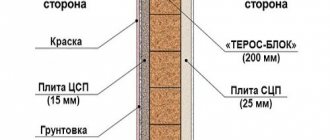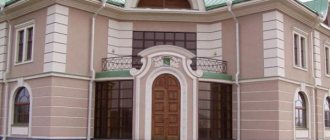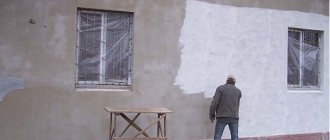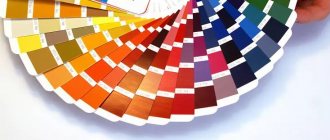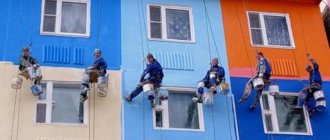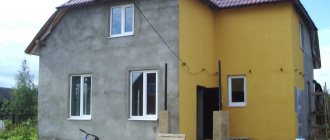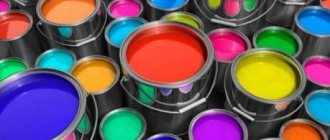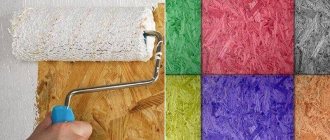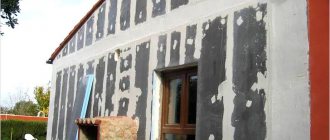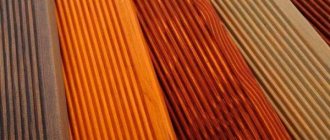About the general principles of color selection
House designs presented on numerous construction sites are in most cases made in neutral shades. This is done so that the colors do not distract from the details of the project, allowing you to more fully appreciate the design. The choice of colors for the facade and roof goes to the owner; it will be successful if you follow the simple rules that guide professional designers.
Before settling on a particular color scheme, you should decide whether you want to highlight your home, emphasizing its advantages, or, conversely, make it invisible, built into the environment. The solution to this question will tell you which direction to move in. The first option will require rich colors and bold combinations, while the second will require a harmony of natural shades.
For fans of extravagant solutions Source indeco.ru
When choosing colors for a country house, it is important to remember some features that are inherent in all colors, albeit to varying degrees. All of them have the following properties:
- Burnout . The more saturated and bright the color, the more noticeable it is. The champion in terms of burnout speed is black; brown, red and lilac roofing will be exposed to the sun to a lesser extent. The best durability is demonstrated by the gray color, which only slightly changes the shade. A white roof is also not ideal; elegant at first, over time it will inevitably turn yellow, and not evenly, but in spots.
- Heat absorption . We remember from a school physics course: the lighter the surface, the more it reflects light, and the darker the coating, the more it absorbs solar energy. Therefore, the further north the house is located, the more practical the choice of dark materials and colors for its facade and roof becomes.
Bright colors become lighter over time Source houzz.com
- Accentuation . Paints can change the external impression of a building. Light shades visually enlarge the object, dark shades make it smaller, but also give clarity to the details. Caution is needed when using several bright colors - this is usually a good solution for a house of a simple shape with a minimum of architectural details.
To simplify the task, it is convenient to approach the selection of a suitable color scheme in one of the following ways:
- Choice of shades of the same color . A common and almost win-win option. One color is divided into successive shades: for the roof, facade walls and smaller details. Buildings made in green, sand or brown tones look harmonious; more boldly - in red or blue.
Choosing shades of the same color Source dvamolotka.ru
- Choice of contrasting colors . The appearance of such a building will be bright and memorable. The color scheme is based on two maximum contrasting colors, for example, chocolate brown for the roof material and pale yellow or beige for the facade. Sometimes, to enhance the effect, facade details (doors, trim, plinth) are also painted to match the roof.
Selection of contrasting shades Source iteragroup.com.ua
- Combination with white color . A universal option, given that white harmonizes perfectly with both pale and rich shades.
The combination with white is also contrasting Source rooftrend.com.ua
- Combinations of several colors . A three-color combination is specified: brown – beige – olive or gray – pink – white. They are complemented by a suitable secondary tone, which is supposed to be used for finishing. With the right selection, even a black facade of a house, complemented by a light roof, will look harmonious and stylish.
Combination of several colors Source krona-yug.ru
Painting the house outside
paint the outside of your house yourself
by following these recommendations:
- The work of painting the facade must be planned by checking the weather forecast. On rainy, windy days or at temperatures below +5 ° C, it is better not to paint the facade.
- The surfaces to be painted must first be primed
. To apply primer to the wall, use the same methods as for applying paint (see above). - Before starting work, all non-painted parts of the facade (windows, doors, slopes, plinth, blind area, etc.) are protected with plastic film.
- Painting work is carried out in dry weather in the absence of strong wind. The outside air temperature must be within the operating range indicated on the exterior paint packaging. Check the weather forecast before starting work.
- To paint the facade at a height, install scaffolding or scaffolding. Painting the facade from the stairs is inconvenient and dangerous.
- A layer of paint is applied to one wall of the house without taking long breaks in work. If you paint part of the wall the next day, there will be streaks on the wall - places with different shades of paint.
- The second layer of paint is applied after a certain break, not earlier than indicated by the manufacturer on the paint packaging.
- In order not to wash the roller or brush before each break in work, wrap the tool in a plastic bag - the paint will not dry out.
The paint is distributed by moving the roller or brush in different directions alternately - vertically, horizontally and diagonally.
Methods for choosing the color of the roof and facade
White facades have not been in fashion for a long time. They have been replaced by more interesting color solutions that are pleasing to the eye and less dirty. This approach to decorating the house entailed the need to install a colored roof, preferably in harmony with the shade of the walls and fitting into the surrounding environment.
Bright facade of a private house with a colored roof
Before you start painting and purchasing roofing materials, try to visualize the color concept you like. An architectural bureau or design studio will help you do this. You can, of course, try to draw an approximate picture with watercolors or crayons, but in the electronic version the colors will look much closer to real ones, and the house itself on the monitor screen will be displayed in a three-dimensional image, so you can view it from all angles, and if you wish, also on background of the surrounding landscape.
Visualization of the color concept of the house facade
Not everyone can afford to order a house and roof color design project. This is not a disaster, because you can decide on the shade range of their decor in another way, for example, by creating templates. The flat projection of the facade is transferred to transparent tracing paper or film. The roof model is cut out separately. Now all that remains is to apply elements to the color layout from manufacturers of paint, roofing materials, etc. and combine them into a single whole. In this way, you can quickly review a lot of combinations, putting aside the most interesting ones in your opinion.
Model of a house for selecting facade and roof color options
Very good sample in nature. Many factors can influence how the color on the roof and facade behaves. The most significant of them are:
1. Type of lighting.
2. The texture of the surface itself.
Options for the texture of the facade of a private house
Do not rush to purchase material for the entire scope of finishing work at once. Try to initially paint or plaster a small section of the facade, up to a square meter. The shade is assessed under a variety of lighting conditions:
- in the morning, at sunrise;
- during the day;
- in the evening, by the light of lanterns;
- in cloudy weather.
The disadvantage of this selection method is that only a very limited number of colors can be tested.
To judge the color, paint a small section of the wall first.
How much paint do you need for walls?
What paint to paint the house?
To choose the right paint, read the previous page about choosing façade paint
for painting the outside of the house.
It is quite possible to do the painting of the facade yourself; you only need time, knowledge and patience.
The paint packaging always contains information about paint consumption. Typically, the specific consumption of facade paint is indicated - the number of liters (kg) that will need to be consumed to paint 1 m2 of facade in one layer, l/m2
.
Sometimes façade paint packages indicate the inverse consumption value - the surface area that can be painted with 1 liter of paint, m2/l
.
Usually the paint consumption is indicated in a certain range
, for example like this: flow rate 0.1 - 0.25
l/m2
. Here, a lower consumption value is for smooth primed surfaces, and a larger value is for rough, textured, unprimed facades.
On the websites of paint manufacturers and sellers you can find calculators for calculating the amount of paint chosen depending on the area of the house facade to be painted, the number of layers and the roughness of the surface being painted. Facade paint is usually applied in two layers.
To paint the outside of a house, the amount of paint is determined by multiplying the area of the surface to be painted - m2
, specific consumption -
l/m2
, number of layers - 2, safety factor - 1.1.
A safety factor of 10% is necessary to avoid the unpleasant situation of running out of paint at the end of the job.
Color combination techniques
The facade of the house can be divided into:
- walls,
- plinth,
- roof,
- additional elements: corners, window and door openings, soffits, gutters, etc.
As a rule, the base and roof are made of one shade, the walls of another. The corners can be the same color as the base or wall, or contrasting (most often white). In the first case, the house will look smaller and neater, in the second - more spacious. Openings, soffits and gutters can be made in a contrasting shade or to match the base.
Designers use different techniques to change the visual perception of a building. Consider them when choosing siding, colors, combinations.
1. Light colors make space appear larger.
Siding in light, pastel shades is good for small buildings to give them volume. It will look advantageous against the backdrop of dark treetops or fences.
!
Light siding gives small buildings volume and makes them visually more spacious.
2. Dark shades make the house visually smaller.
This finish is suitable for large cottages that want to give a strict look. In addition, dark colors will help the house “get lost” among the trees.
3. Bright colors give your home a fresh look.
This is a bold and interesting solution, but you should not use more than one bright color on the facade. The corners can be emphasized with a contrasting shade, which certainly matches the main one.
4. Contrast is used for buildings with complex architectural forms.
The walls are made in one color, and all protruding elements are made in another. Moreover, if the second one is lighter, the facade will look lighter and more elegant.
How to highlight architectural elements of a building with color (photo No. 2)
5. Buildings of simple shape are a field for design experiments.
Here you can combine different shapes and colors to create a spectacular look. But they must be in harmony with each other.
Colored details change a simple facade (photo No. 3)
6. Dark bottom, light top.
Classic combination: dark base and light walls. The color of the base can (but not necessarily) be matched to the roof and reinforced with corner elements, finishing of window and door openings.
Classic combination (photo No. 4)
7. Inversion
Inversion in facade decoration (photo No. 5)
A bold decision that not every homeowner dares to make: a light base and dark walls.
Priming the walls of the house outside
The primer allows you to:
- strengthen the dusty base;
- increase the adhesion (adhesion) of paint to the base;
- reduce water absorption of the coating;
- reduce the consumption of facade paint.
Facade paint spreads more easily over a primed surface, and its consumption is noticeably reduced
.
It is best to use a primer recommended by the façade paint manufacturer.
chosen to paint the exterior of the house.
The quality of painting the facade of a house can be improved if the primer is tinted to match
, close to the color of the façade paint.
Facade paint diluted with water is sometimes used as a primer.
in a 1:1 ratio.
The primer is applied to the wall surface in the same way as paint. Before painting, the primer must be allowed to dry completely for at least 24 hours.
How to choose the color of the facade
Home ownership is a territory of comfort; nothing here should cause discomfort. Everyone has their own color preferences and understanding of how to choose the color of the facade of a private building.
Important! Color affects your sense of self, mood and even health.
Even the recommendations of the most authoritative experts should not influence the choice if you initially don’t like something. For example, if the color black or dark green causes internal rejection.
The fashion for certain color preferences will pass, but you will live in this house for many years.
The influence of tradition and landscape on the choice of flowers
Most often, the selection of color combinations for the facade and roof takes into account the location, features of the local landscape and national traditions:
- In hot southern regions, cool shades are popular, from white and lilac to emerald and bright blue.
- In regions with cold and long winters, warm colors are popular: yellow, chocolate, red, orange.
- In lowland forest regions, facades and roofs in natural shades are common - earth, grass, moss, sand.
- In flat steppe regions, bright finishing materials are used to decorate the roof: red, cherry or orange.
A warm option for a cold winter Source doka-metal.ru
- Near a lake , river or on the sea coast, a combination of white, turquoise, blue and light blue is popular.
- Country cottages look especially attractive in pastel colors.
- If the estate is surrounded by an extensive garden , its design can include a bright palette with yellow, purple and lavender accents.
- Private house in a residential area . Modern urban architecture involves experimenting with bright and unexpected color combinations.
- Building in the old quarter . You will have to adapt to the style of the environment so as not to destroy the historical surroundings.
Facade in a pastel palette Source doka-metal.ru
Green algae on the facade - how to prevent and remove
Green algae on a wall always indicates high humidity, which encourages algae growth.
Houses located near forests and parks, in areas with high humidity (near bodies of water), are especially vulnerable to biological pollution. Mainly only the northern and western walls are susceptible to green invasion. This is due to the fact that winds from the west blow more often, and rain falls on the walls from these directions, and the sun is less frequent in these places. Algae and fungal spores thrive on damp surfaces, and on south-facing walls the sun dries out the façade.
It is enough to disinfect walls with a slight degree of contamination with a preparation to combat microorganisms, and then rinse them with water under pressure. If after disinfection traces of algae remain, then the color will need to be restored - paint the façade with paint containing biocides.
It should be remembered that the active period of most biocides is from three to five years. After this time, in areas particularly susceptible to microbial contamination, facades should be re-protected by spraying the product. I know of no means of providing long-term permanent protection against algae.
The appearance of algae should be prevented regularly, because prolonged exposure to it not only spoils the paint, but can lead to weakening and damage to the plaster.
Small cracks in the plaster layer can be filled with putty. It is convenient to apply it from a cartouche, the tip of which must be cut so that a thin stream of mass is created.
The depressions after impact are filled with a mass applied with a spatula.
More Articles on this topic:
⇒ Decorating the walls of the house with facade plaster ⇒ Which facade paint to choose
More articles on this topic
- Finishing, covering the walls of the house with vinyl siding
- Reinforcement of masonry walls made of aerated concrete and gas silicate blocks
- Magnesium or aluminum anode for water heater
- Sewage system with active septic tank Topas for a private house
- House, wall made of thermal block, thermal wall, flint granite, polyblock
- Lessons from the Maidan for Russia.
- We make paths and platforms from tiles and paving stones on the site
- Everything you wanted to know about roof windows
What is the advantage of a light facade?
It is better to take a lighter tone after construction, and then change something later, choosing more saturated tones from the same palette. A base that is too dark is difficult to paint over later.
If you want a light gray façade, it will be difficult to transform a brown or blue building. You will have to cover it with several layers of your preferred color.
If this is an old country building that does not have high aesthetics, you should not visually highlight it; it is enough to update the old whitewash or paint.
Multicolor facades
The building can contrast in color with the surrounding panorama - a kind of accent to give the appearance of the estate a complete look.
In some cases, green and brown shades are chosen so that the house “dissolves” against the background of the forest and “drowns” among the thickets of the garden.
Multi-colored facades are difficult to make harmonious. It doesn't always look beautiful, so it makes sense to choose 2-3 colors, with one being the background.
Attention! According to the coloring rules, the foundation or base should be darker.
The color of the white façade roof should not blend in with the main tone. Usually it is darker, but a lot depends on the material and style of the building.
How to store paints?
Paint packaging should be protected from direct sunlight and frost. The paint should be stored at temperatures from +5 to +25 degrees C in tightly closed packaging. Paint stored under such conditions remains usable even after the expiration date indicated on the packaging.
Products for Auto
⇆
If the paint has flaked during storage, mix it thoroughly with a mixer attached to an electric drill, and the paint will become usable again.
Combination with nearby objects
Painting should be done based not only on your taste preferences, but also taking into account the color scheme of buildings and structures nearby.
If the building is located in a historical area, it is necessary to adhere to the color scheme characteristic of the area. Traditionally, for houses located outside the city, the most acceptable solution would be to use soft pastel shades.
If the house is surrounded by greenery, surrounded by bushes and trees, it is best to use very light shades for painting. A building located in an open area can be enlivened with bright colors.
The south side of the house requires the use of muted colors - intense sunlight will make the facade lighter and brighter. Think about how the house will look at different times of the year - against a backdrop of white snow or bright green spaces.
Using color, you can focus attention on what you want to highlight and make some imperfections invisible.
How to apply paint?
Facades are most often painted with a roller, brush or spray gun.
The choice of tool is determined by the consistency (viscosity) of the paint, the texture of the surface to be painted and the qualifications of the workers.
Walls with a smooth surface
Paint with a brush or short-haired roller. Painting with a roller is more convenient and faster than with a brush, and less paint is consumed.
When painting walls with a textured surface
or directly on the brick, use a wide brush with long bristles.
—>
You can use a spray gun to paint walls of any texture.
, both smooth and embossed.
Painting a house with a spray gun requires performers to have higher qualifications and experience working with this painting machine. It is necessary to choose the right paint viscosity and select nozzles for the sprayer of the device. You also need practical skill in applying paint evenly to the surface of the wall. It is better to entrust painting a house with a spray gun to specialists.
In the case of using special high-viscosity textured paints with filler
, to apply paint to the facade, in addition to the above tools, they also use a spatula.
Color compatibility table
Of course, the final choice depends on the taste of the home owner, but in order to make the choice not so difficult, it is easier to use the compatibility rules. The most trustworthy and popular are special tables developed by Swedish psychologist Max Lüscher. Based on his recommendations, specialists compiled a table relating to the issue of combining the colors of walls and roofs and ensuring maximum color harmony.
5 means an excellent combination, 4 means quite acceptable, 3 means not very good, 2 means incompatible.
